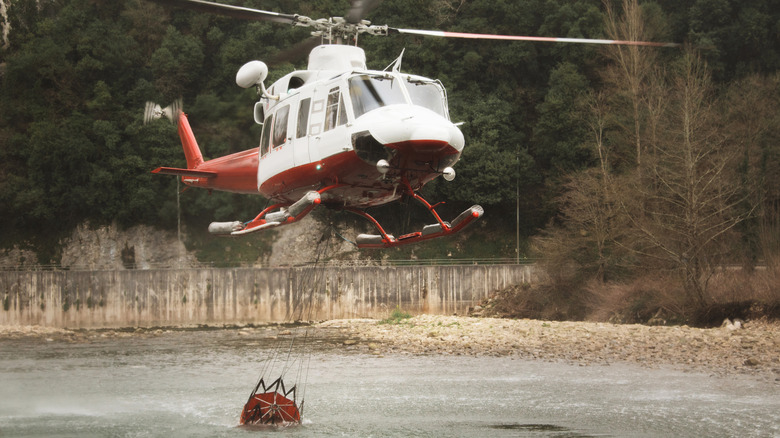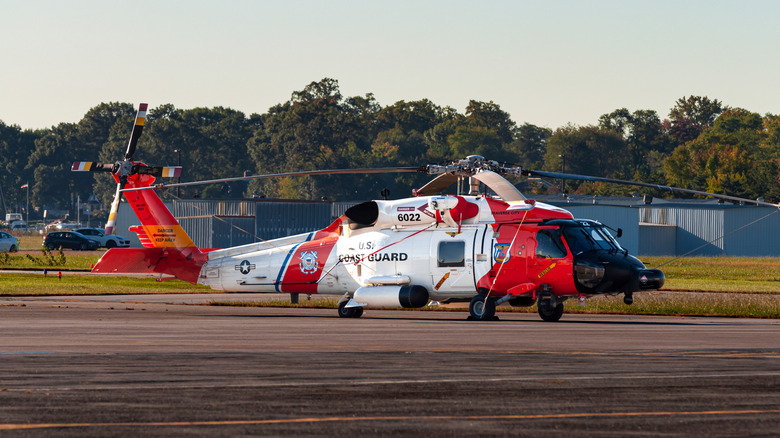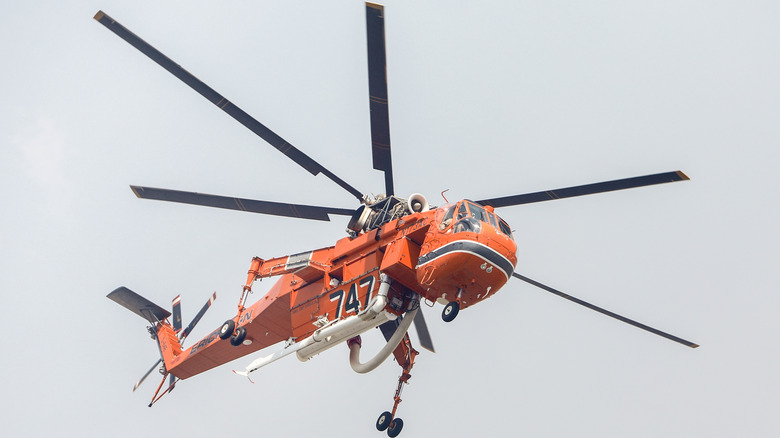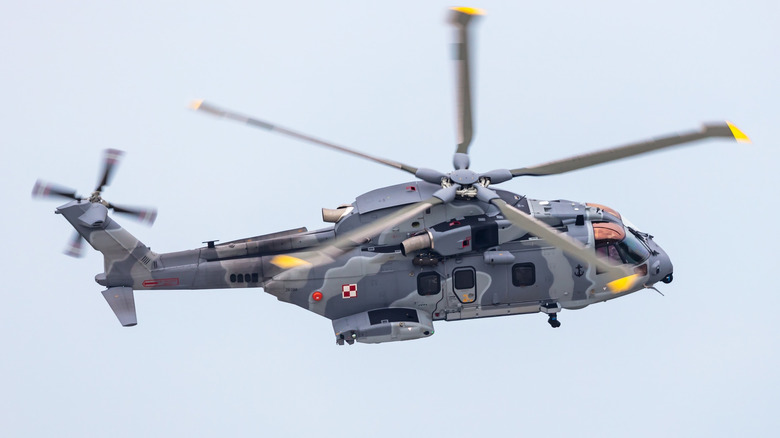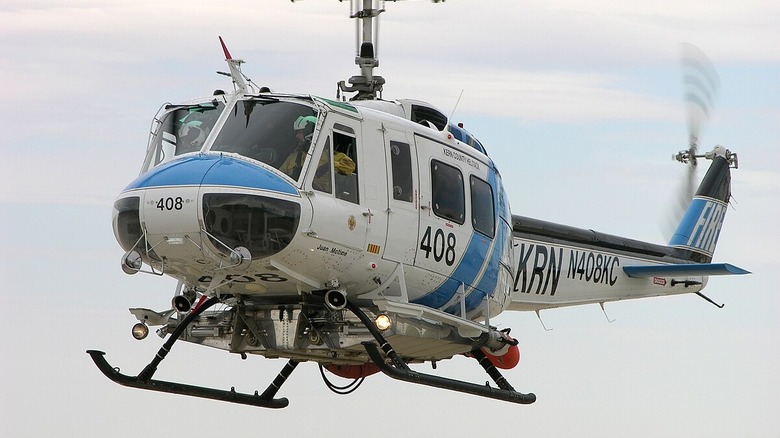5 Intriguing Military Helicopters Used For Rescue Missions
The helicopter's unique capabilities make it a versatile craft. Speedier and without the limitations of earthbound vehicles, a helicopter's ability to reach respectable speeds, hover in place, and serve as a stable platform for various missions makes it a time and lifesaving device.
The first practical helicopter, the Sikorsky VS-300, took to the air in 1939. While the mass deployment of military helicopters first occurred during the Korean War between 1950 and 1953, the first military helicopters served little-known uses during World War II. The first military helicopter mission took place in the China-Burma-India Theater of World War II, when Lieutenant Carter Harman flew a YR-4B on the world's first helicopter combat mission. His task: a rescue. Which brings us to the wonderful humanitarian nature of the helicopter.
The world's most iconic military helicopters get plenty of attention for their high performance, menacing silhouette, and incredible capabilities. We've seen some strange examples, but the humble rescue helicopter has some trick gear and gadgetry that saves lives in emergencies.
1. Maritime Rescue: Sikorsky MH-60T Jayhawk
The United States Coast Guard was established in 1790 to enforce the fledgling nation's customs and revenue laws along its borders. The organization today is part of the Department of Homeland Security, tasked with the enormous responsibility of arresting smugglers, responding to national emergencies, and aiding sailors in distress. The Sikorsky MH-60T Jayhawk has been part of the Coast Guard's toolbox since 1990.
The Jayhawk is an all-weather medium-range recovery (MRR) helicopter that answers the Coast Guard's needs for rapid response. Based on the MH-60 Blackhawk used by the military, the Jayhawk can fly for up to 6.5 hours and range as far as 700 nautical miles (nm) with a maximum speed of 170 knots. At 64 ft long, its quad rotor has a diameter of 54 feet, which, combined with a pair of General Electric T700-GE-401C engines generating 1,890 horsepower each, gives it a maximum takeoff weight of 21,884 pounds.
The Jayhawk can be equipped with a single 7.62 mm machine gun for disabling the engines of non-compliant craft, but its primary mission is maritime rescue. The current generation T-model houses a crew of four: pilot, co-pilot, crew chief, and rescue swimmer. The swimmer deploys into the water or onto a stricken vessel to provide aid. Victims of disasters are hoisted aboard the Jayhawk with a 61-meter cable attached to a winch with a 600-pound capacity.
2. Air Ambulance: Airbus H145 D3
We've come a long way since the Korean War, when wounded soldiers were strapped to the exterior of helicopters for quick transport to a hospital unit. When mortal injuries were concerned, helicopter safety came second. Today's helicopters ride safely and smoothly enough to act as an emergency room. With enough room for a pair of wheeled stretchers alongside a suite of medical equipment and accommodating between three and five personnel, the H145 doesn't just transport the injured; it serves as a high-flying hospital room en route.
Airbus partnered with emergency medical service (EMS) providers to design multiple EMS cabin choices for the H145. The company also focused on noise reduction, as its mission set will involve the H145 flying in urban areas near hospitals.
The H145's twin Safran Arriel 2E engines provide a maximum takeoff weight of 8,300 pounds. As a quick-response unit, it doesn't have the same loiter or flying time as a maritime rescue helicopter. With a top speed of 140 knots, a range of 351 nm, and an endurance of 3.5 hours, a strategically placed H145 can provide lifesaving services to thousands over its career.
Time is critical during medical emergencies, and not all of them happen near an airstrip. That's why ambulance helicopters have proven so valuable in lifesaving missions. The Airbus H145 D3 is a top pick for medical transport and rescue, thanks to its smooth operation and spacious cabin.
3. Firefighting: Sikorsky S-64 Skycrane
Everyone has seen the dramatic footage of the cargo plane coming in low over a crystalline California lake, scooping up thousands of gallons of water like a pelican, and then lumbering over the next mountain range to drop it on a nearby wildfire. What gets less attention is the special helicopters performing similar duties.
Not quite a military helicopter and not fully a civilian one, the Sikorsky S-64 Skycrane was initially designed as a military cargo transport. With a specialized fuselage intended to lift and transport external pods, it was once the largest helicopter ever operated by the United States Army. It was beastly and reliable. Still, few likely foresaw how its capabilities primed it for a thriving second career as a firefighter.
Erickson Air Crane purchased the manufacturing rights to the S-64 in 1992 and designed a 2,650-gallon tank, along with a system that enabled the helicopter to hover over bodies of water and fill the tank in seconds. This system later developed into a snorkel that helicopters can use to suck water from lakes or ponds. The innovation made the S-64 ideal for carrying water or fire-retardant chemicals for precise application to wildfires.
If that wasn't enough, Erickson also designed a nozzle for the front of the craft that can spray retardant or water up to 55 meters, meaning a Skycrane could hover near a burning ship, suck up seawater with its snorkel, and act as a fire engine to put out the flames. With a lift capacity of 20,000 pounds and a maximum gross weight of 42,000 pounds, the latest S-64E model utilizes twin 4,500-horsepower engines to extinguish fires worldwide.
4. Search and Rescue: Leonardo AW101
The Coast Guard receives deserved accolades for its naval derring-do, but those lost or hurt on land have other needs. The Leonardo AW101 meets these needs with modern equipment, an exceptionally modular cabin, and enough space to fit up to 25 troops in the rear. Of course, as a dedicated Search and Rescue platform, the AW101 will carry more medical gear than combat equipment.
A maximum range of 810 nautical miles at 5,000 feet in twin-engine cruise and a maximum endurance of 7 hours and 40 minutes provide the AW101 with ample travel and loitering capability. Part of that is due to the unusual triple-engine configuration employed by Leonardo, with GE CT7-8E turboshaft engines combined for a gross maximum takeoff weight of 34,390 pounds.
If that wasn't enough to convince you of the strength of this platform, consider that Leonardo estimates that with four to six crew members, the AW101 could rescue as many as 20 people while simultaneously providing trauma treatment to the injured or rescue as many as 50 people in a single lift. The AW101's advantages make it attractive for uses beyond search and rescue, although it excels in that mission set. The Polish Navy first flew it in 2021, and it also garnered a Hollywood turn in "Jurassic World Dominion."
5. Disaster Relief: Bell 205A-1++
Disaster relief missions combine the challenges of search and rescue, maritime operations, and medical emergency services and spread them across a wide geographical area, sometimes with millions in population. Helicopters make excellent platforms for establishing services, security, and lifesaving resources to remote or disconnected communities.
The Bell 205 A-1++ is a Type 2 helicopter, rated for a top speed of 125 mph, that serves emergency personnel across the United States. Its passenger capacity of nine and a maximum load of 4,000 pounds doesn't make it the most potent or accommodating helicopter on this list, but it suits its mission well.
As a single-engine helicopter, it is not as fuel-ravenous as some. The single Lycoming engine powers a 48-foot rotor blade. Its combination of efficiency and utility, along with its abilities to deploy in cases of disaster, also makes the Bell a popular option for forestry and civil transport applications.
